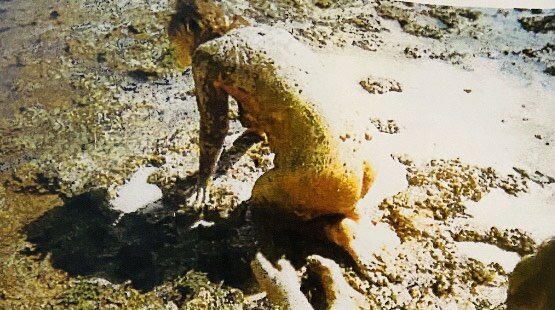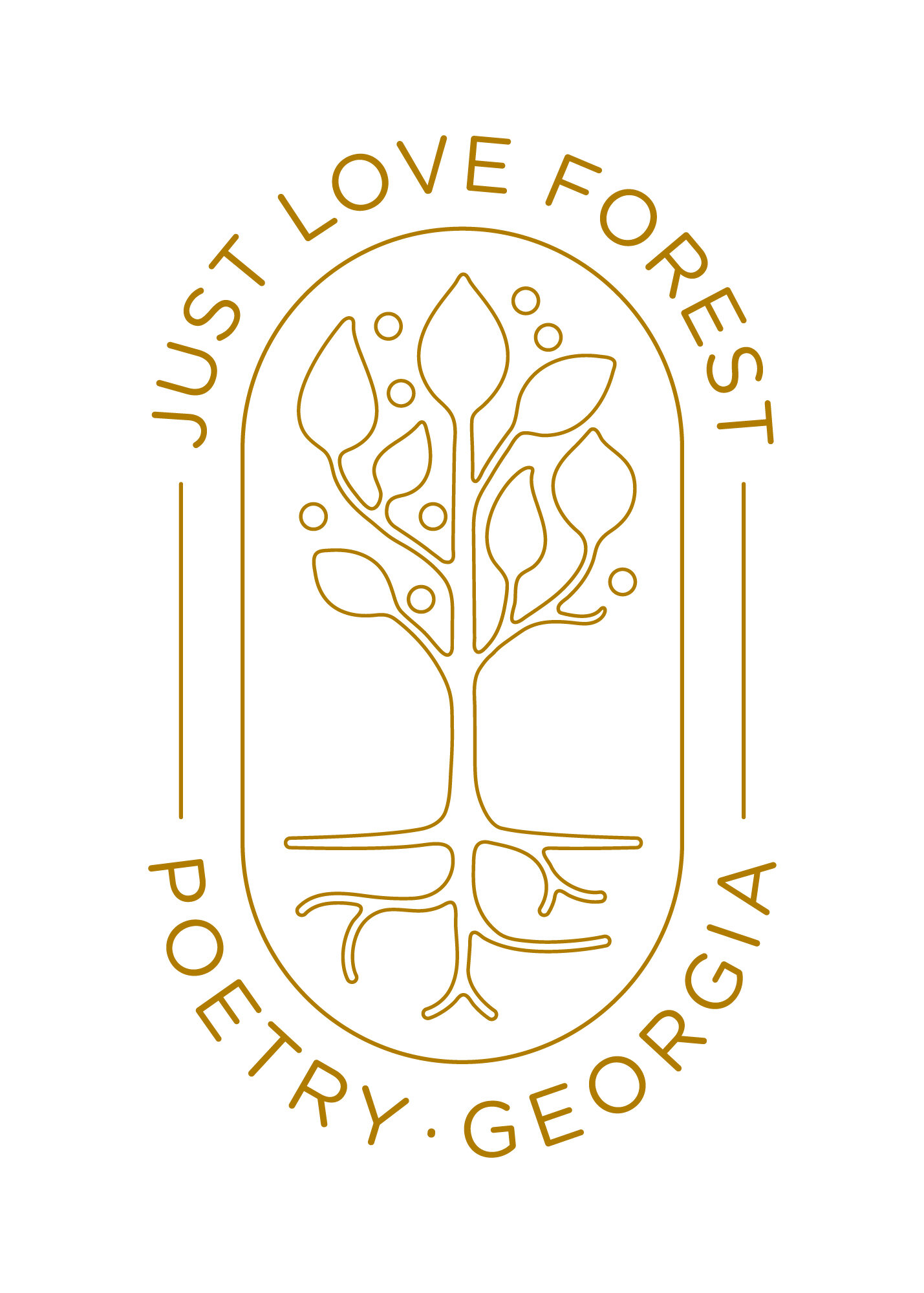
-
Tulip, Poetry, Georgia & Serpentfoot
Tulip was a frontier town in Chattooga County, as a station on the Central of Georgia Railroad, located near the Floyd County line. The name is derived from the tulip tree (yellow poplar) Liriodendron tulipfera that is found throughout the Basecamp area of Just Love Forest.
It was re-established as the town of Poetry in 1973 by Anne C. Otwell, who later changed her name to Serpentfoot Serpentfoot, who wanted to put "poetry" on the map, and create a colony of poets.
Anne Clay Otwell was well known in Georgia as a poet, editor, and publisher of the “Poets Monthly” paper. She was also president of the Poets of Georgia Club, and mayor of a ghost town once called Tulip (also previously called Sprite and Kincaid) located in Chattooga County, Georgia.
She renamed the town Poetry, Georgia and intended to create a colony of poets there, attracting visitors such as President Jimmy Carter to whom she presented an award on behalf of Poetry.
After going broke, she lived as a hermit in the woods of Poetry, Georgia in a teepee and lived completely off of the land for a year. She later wrote her book, the “Bad News Gospel.” She also started the "Church of Nudist Native and Naturalist with a Mission / NNNWM also known as “Our Greater Self Co-op.” The picture on the header is one of her old pictures shared of their nude mud bathing many years ago. The primary message is that “we are nature.” She remarked that the first clothes weren’t leaves, they were mud. “We are just a little part of nature,” she often exclaims.
In 1995, Anne Otwell legally changed her name to Serpentfoot Serpentfoot. She offers, what is all foot and no foot? The serpent. Serpentfoot's "Bad News Gospel" is a work in progress as 1970s news clippings, typescript, and snippets of printed text, with handwritten explication in the margins dated as recently as 1996.
She was jailed for three years of a five year sentence for speaking out against Christian prayer being used in government meetings due to separation of church and state. She protested by removing her clothes at the town hall meeting and proclaiming, “behold, God in the flesh,” to make the point that God is everywhere and in everyone and shouldn’t be relegated to a single religious practice.
She has multiple degrees from Berry College and Georgia Highlands College in Law, Religion and Anthropology. She still resides where there used to be a historic Native American log cabin, until it burned down.
Later owned by timber companies, the 716 acres of Just Love Forest was protected in perpetuity under conservation easement and purchased on May 4th, 2020. It is now Georgia’s first dedicated forest therapy resort.
Inspired by the wisdom of the beings who gathered here before us, we remember we are just part of nature.
After writing a letter to Serpentfoot she agreed to meet and the link below is the recording of our conversation in her home nearby the entrance to Just Love Forest. She visits regularly and we honor her as a matriarch.
-
Koasati, Muscogee creek & later Cherokee
The area of the Southern Blue Ridge Mountains is one of the oldest inhabited areas of Georgia with a history going back beyond the Mississippian Indian Cultures. Originally for centuries it was part of a vast misnomer of Indian culture and heritage. Once the Spanish and Europeans invaded the lands of Georgia from about 1540–1738 there was a loss exceeding 95% of the indigenous populations from diseases such as smallpox, enslavement and battles. There were twenty-one different tribal factions living across what became the state of Georgia.
The lands of Georgia were originally claimed by colonist Oglethorpe for Britain and ran from the Atlantic Ocean to the Mississippi River and beyond. The intruders pushed ever westward into Georgia displacing various tribes of indigenous peoples as they went. In the early 1700’s the English made treaties with many of the tribes to supply them with trade goods and metal tools causing a debt, which the British collected in furs and deer hides which never seemed to be enough. This practice soon depleted Georgia of her herds of wood buffalo and white-tailed deer. The British then began making their collections in the form of ceded lands. The American Indians knew nothing of land ownership. Their feelings were that their God had lent the lands to tend and care for all time.
THE KOASATI
Koasati is pronounced koh-uh-sah-tee. It comes from the people's own tribal name, Kowassati, which means "white cane people." Koasati Indians originated in the Mississippian Period (AD 900 to 1600), one of several eras that archaeologists use to study Native Americans history in present-day southeastern and midwestern United States. They were traditionally agriculturalists, growing a variety of maize, beans, and squash, and supplementing their diet by hunting game and fish. They are known for their skill at basketry. They work hard to preserve their Koasati language, their traditional crafts, such as their longleaf pine needle basketry, which is renowned world-wide, and their cultural traditions, including dancing, clothing styles, songs, and food-ways. They currently live in Lousiana and Alabama and were part of the Creek Confederacy.
Around the time of the American Revolution in 1773 the Cherokees relinquished their lands near the coastlines and moved inland, displacing indigenous tribes as they went. The Muscogee Creek tribes had controlled most of Georgia since the 16th century. They were removed to current day Alabama and then further to Indian Territory of Arkansas and Oklahoma by 1827.
The Cherokees continually made concessions to the English and through efforts of acculturation tried to adopt many of the colonists white ways in order to exist in the lands of Georgia together as a peaceful peoples. Both the new Americans and British colonizers were rapidly pioneering the lands, always wanting more.
By 1786 the Cherokee had a model government. It followed many of the precedents of the fledgling government of the American Colonies. By 1825 the capitol town of Echota was moved to New Echota on the shores of the Oostanaula River to the west of Ellijay in Gordon County now. Located there were the printing offices for the Phoenix newspaper a dual language newspaper written in Cherokee and English.
-
Earliest Inhabitants
For thousands of years before the dawn of written records, the Southeastern United States was home to humans that history traditionally called ‘Indians,’ (thanks to Christopher Columbus). Only fairly recently in the modern scheme of things did they acquire the definitive status of indigenous peoples or native Americans. Prehistoric Georgia has been inhabited for at least 17,000 years, throughout the Paleoindian, Archaic, and Woodland periods, as evidenced by sites along the Macon plateau at the fall-line. Archaic period pottery found in a mound at Stallings Island near Augusta indicates it may be one of the oldest mounds to be confirmed in North America, although the base of another mound near Savannah’s Irene site, known as the Bilbo Mound, may be even older — it’s been dated at 3,540 B.C.
Early inhabitants of Georgia can be classified as Wandering Hunters, Shellfish Eaters and Early Farmers who lived in small familial groups, employed limited farming skills, and hunted fish and game along the major waterways. The evolution of various Southeastern Native American cultures from the Archaic Period to the Woodland Period was marked by the emergence of three stages of ‘Pre Columbian’ occupation, dating from 1000 B.C. to 1000 A.D. It was during these final years of pre-history that some say the subsistence of the nomadic hunter-gatherer was replaced by woodland farming.
Achievements credited to the “Neolithic Revolution” of the Early Farmers include more substantial dwellings and permanent settlements, decorative symbolic pottery (Swift Creek & Weeden Island — Middle/Late Woodland Period), limited agricultural advancements, and the use of the bow and arrow. They also participated in the broader Adena, Hopewellian and Fort Ancient trading cultures.
Along the Etowah River southwest of Cartersville, Georgia, in Bartow County, the Leake Mounds site contains the remains of a prehistoric occupation that lasted from approximately 300 B.C. until 650 A.D. A major center during the Middle Woodland period, it figured prominently in the interaction among peoples throughout the Southeastern and the Midwestern United States. Swift Creek pottery has been discovered throughout a major portion of Georgia as well as portions of surrounding states, and the Leake site is at the northernmost edge of its distribution.
Serpentfoot and Bala on the summit of Bhakti Mountain, Just Love Forest, Poetry GA.


